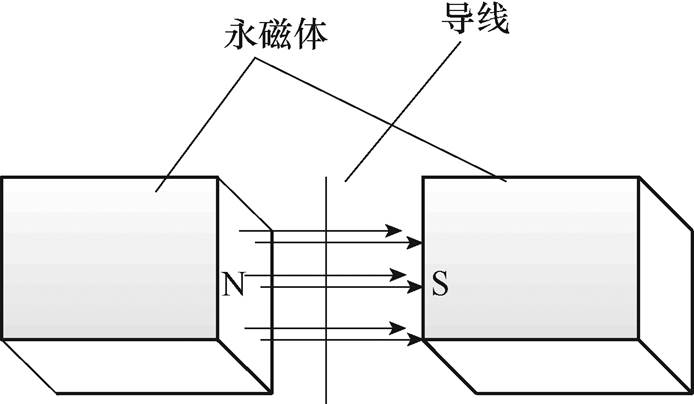
图1 安培力原理
Fig.1 Schematic diagram of ampere force
摘要 音圈电机是一种不需要任何机械传动环节,就可以将电能转化为直线运动机械能的直线电机。由于具有结构简单、体积小、响应速度快、定位精度高、易于控制等优点,音圈电机广泛应用于国民经济的诸多领域。该文首先简述音圈电机的理论基础,阐述音圈电机的工作原理、结构分类以及各结构的特点;然后,结合国内外学者对音圈电机的结构优化,对音圈电机提高力常数和定位精度的方法进行归纳总结;最后,对音圈电机的主要应用领域进行综述,并对其发展趋势和研究热点进行讨论和展望。
关键词:音圈电机 结构优化 力常数 定位精度
音圈电机是一种直接驱动的无迟滞设备[1-2],利用永磁体产生的磁场与通电线圈的相互作用产生驱动力。音圈电机具有结构简单、动态响应速度快、无齿槽转矩、高线性度等优点,在高精度定位伺服系统中得到广泛应用[3-4]。随着工业化不断升级,快速化、小型化、精密化的电机已经成为各国研究重点,因此音圈电机得到了广泛的关注。
音圈电机属于特种直线电机范畴,没有中间传动环节,极大地简化了驱动机构,提高系统紧凑性。在直线运动系统中,直线电机在效率、推力控制和系统体积等方面比旋转电机更具优势[5-6]。相对于U型直线电机和平板直线电机,音圈电机具有更好的高频响应特性,可以实现高速往复直线运动,特别适用于定位精度高的短行程伺服控制系统中。但是,音圈电机作为直线电机同样存在推力密度低、端部效应、线圈磨损等缺点[7-8]。针对直线电机的这些问题,国内外研究学者做了大量研究实验,且取得了一定成果。如采用高磁性材料、使用Halbach磁极阵列代替传统磁极结构、将超导材料应用于电机绕组制作、无线充电等[9-11]。
本文回顾总结国内外学者对音圈电机的研究成果,对音圈电机的技术概况进行总结归纳。首先,简述音圈电机的工作原理、结构分类以及各结构的特点;然后,结合国内外学者对音圈电机的分析研究,对音圈电机存在的输出力低、端部效应等问题以及相应问题的解决方案进行归纳总结;最后,对音圈电机的应用领域进行综述,并对其发展前景和研究热点进行讨论。
音圈电机是一种往复频率极快的直驱式电机,一种基于安培力原理而设计的直线电机,属于特种电机范畴,因其工作原理与扬声器类似而得名[12-13]。安培力原理如图1所示。

图1 安培力原理
Fig.1 Schematic diagram of ampere force
图2所示为音圈电机结构,音圈电机主要由线圈、永磁体和磁轭三部分组成。其原理为线圈动子在永磁体中通电后,会受安培力作用并产生垂直于线圈平面方向的运动,可通过控制线圈电流的方向来控制线圈运动的方向,通过控制线圈通过电流的大小来控制线圈所受推力的大小[14]。音圈电机的磁学原理、电子学原理、机械学原理及数学模型的搭建在相关文献中有详细讲解[15-16]。图中,1为磁轭,2为永磁体,3为线圈(图3~图10中的1, 2, 3同图2)。
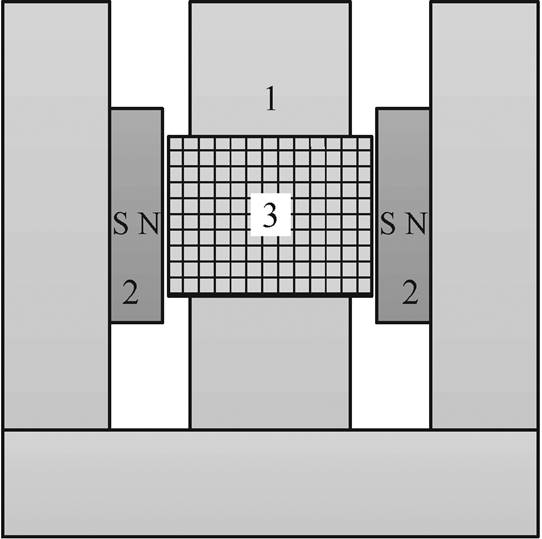
图2 音圈电机结构
Fig.2 Structure diagram of voice coil motor
1.2.1 外磁式与内磁式结构
音圈电机最初应用在磁盘磁头定位机构[17],1970年IBM推出的IBM3330存储设备采用外磁式长音圈电机作为磁盘定位机构,外磁式结构如图3a所示,永磁体暴露在电机外部,磁力线向外部发散,对外部造成磁干扰,所以外磁式结构需要采用磁屏蔽机构消除漏磁对磁头读写的影响[18-19]。图3b为内磁式结构,利用音圈电机的外壳作为磁屏蔽,永磁体、气隙和磁轭形成磁回路,减少漏磁。但是在电机轴开孔的场合不能使用内磁式,如在光刻机[20-21]中,激光束需要穿过音圈电机,此时不能采用内磁式结构。
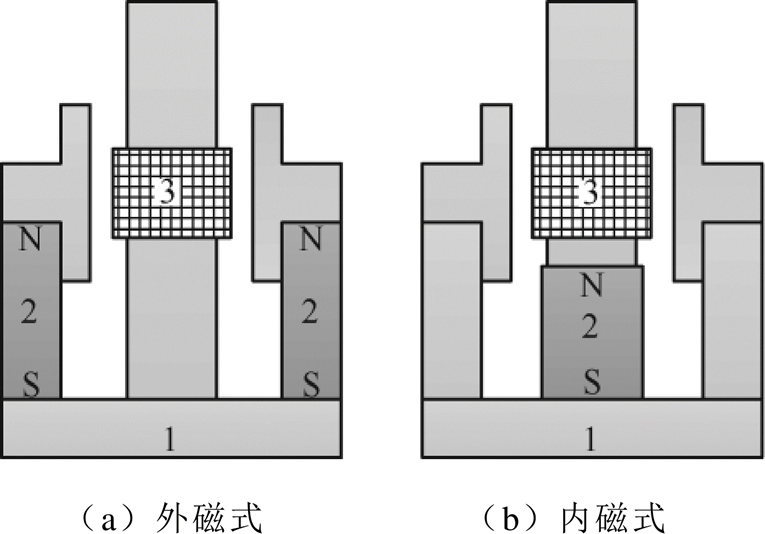
图3 外磁式和内磁式音圈电机结构
Fig.3 Structure diagram of external magnetic and internal magnetic voice coil motor
1.2.2 短音圈与长音圈结构
短音圈与长音圈音圈电机结构如图4所示,根据电机工作气隙长度与音圈长度的大小关系,可以将电机分为短音圈结构和长音圈结构。长音圈电机由于只有一部分线圈在工作气隙中,电能利用率较低,端部漏磁严重[22-23];优点是电机体积相对较小。短音圈电机的动子质量轻、响应速度快,但是铁磁机构大、成本高。随着永磁材料的发展,将稀土永磁材料用于音圈电机设计能够极大地减小电机的体积[24-25],在IBM3330之后的IBM3340、IBM3350等产品均采用短音圈结构[19]。

图4 短音圈与长音圈音圈电机结构
Fig.4 Structure diagram of short voice coil and long voice coil motor
1.2.3 动圈式与动磁式结构
动圈式与动磁式音圈电机结构如图5所示。在动圈式音圈电机中,固定磁体在线圈行程内产生均匀磁场,线圈是运动部件,响应速度快,但是存在飞线问题且散热能力差,可靠性较低,一般广泛应用于小功率领域[26-28],不适合于功率要求较高的场合。文献[7]中提出无线充电的方法在理论上解决了飞线问题。动磁式音圈电机的动子是永磁体阵列,电机结构紧凑、功率密度高,可实现无摩擦,但是对永磁体的体积质量和机械强度有一定限制,且电机结构复杂,要考虑磁场耦合、推力非线性和涡流损耗等问题[29-30]。
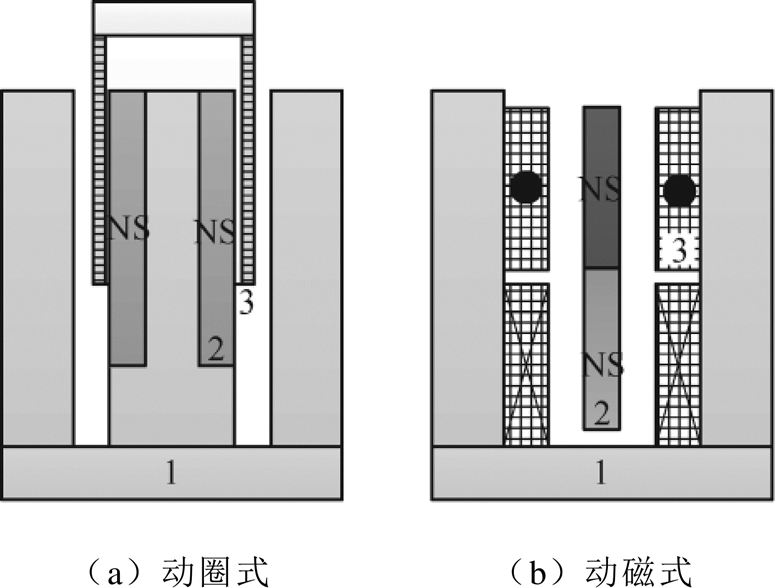
图5 动圈式与动磁式音圈电机结构
Fig.5 Structure diagram of moving coil and moving magnetic voice coil motor
1.2.4 平板形弧形与圆筒形结构
根据电机的外形不同,可以将电机分为圆筒形、弧形和平板形结构。图6所示为音圈电机实物。平板形与弧形结构相对简单,制作工艺成熟,但是漏磁相对严重,永磁体利用率低,产生的推力较小;圆筒形音圈电机的永磁材料利用充分,能够产生较大的推力,但是其环形结构的永磁阵列充磁成本相对较高,且其行程低于平板形[31-32]。
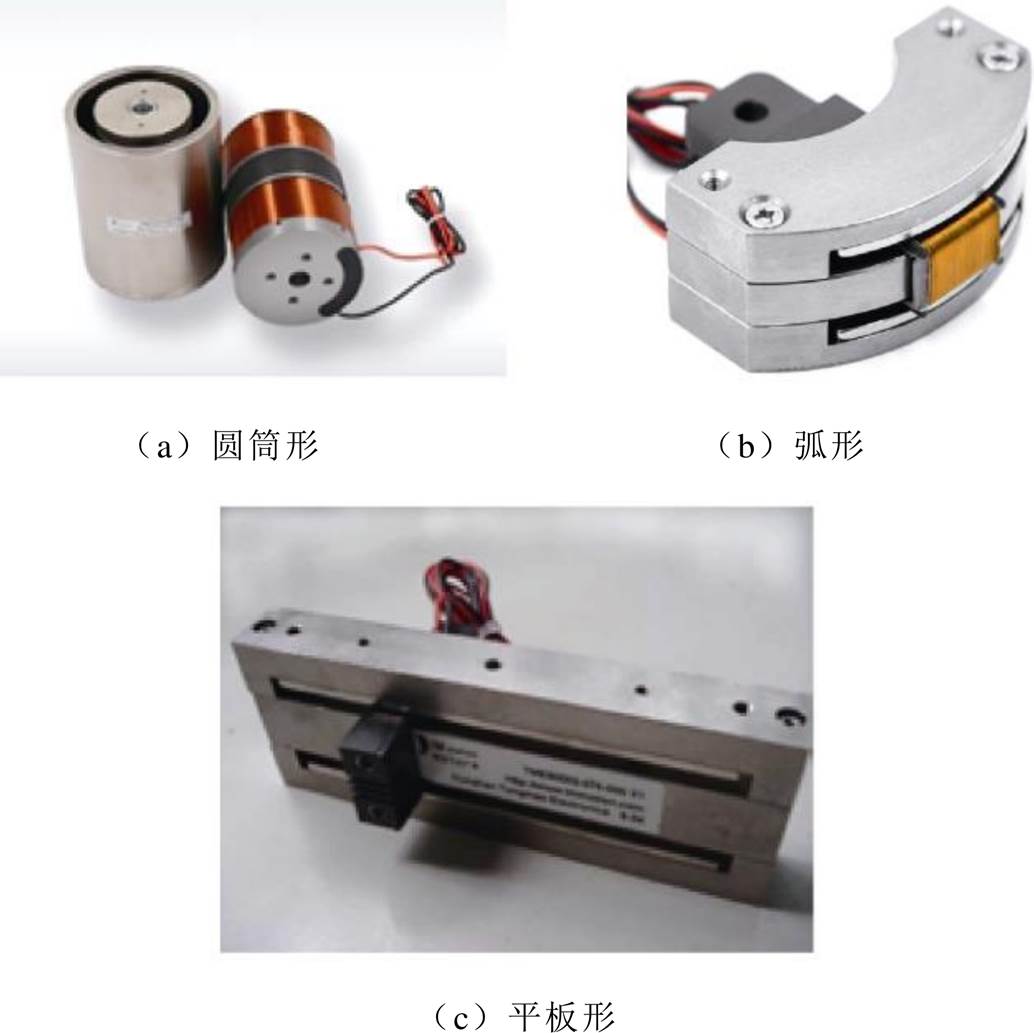
图6 音圈电机实物
Fig.6 The picture of voice coil motor
内磁式结构有效地解决了外磁式结构存在的磁干扰问题,但由于结构限制在特定的场合必须使用带有屏蔽的外磁式结构;随着永磁材料的发展,短音圈结构相对于长音圈结构的优势越来越明显;动圈式结构相对于动磁式结构简单,线性推力便于控制,但存在飞线问题;平板形和弧形结构简单,但是推力较小,圆筒形结构相对复杂,但推力较大。
音圈电机以其优秀的动态响应和定位精度,使得磁盘存储技术得到极大提升,随着磁盘存储容量的增加,对音圈电机的推力提出新的要求,并且由于音圈电机的优秀性能,在激光、快速反射镜、引线键合机等需要精密控制领域得到应用[32-34]。音圈电机的有效气隙较大导致气隙磁通密度较低,进而影响电机的推力,最初设计音圈电机首要考虑的是提高音圈电机的出力。由于增大电流会有损耗、散热等问题,提高力常数的主要方法是增大气隙磁通密度。
在文献[35-39]中,对如图7所示的传统单极型、单面多级型和双面多极型三种磁极结构进行分析对比。在传统单极型结构中,由于一段磁轭的存在导致电机的左右磁路不对称,容易产生偏心问题。采用差动式结构,减小绕组电感和电枢反应,抑制不平衡推力。采用多级型磁极结构不仅能够改善偏心问题,在相同体积和永磁材料下,多面多级型磁极结构能够在一定程度上提高气隙磁通密度,改善电机推力。但是由于电机磁轭底部的饱和问题,增加径向充磁磁钢厚度,气隙磁通密度不是呈线性提升,且磁通密度提升有限,永磁体利用率较低。
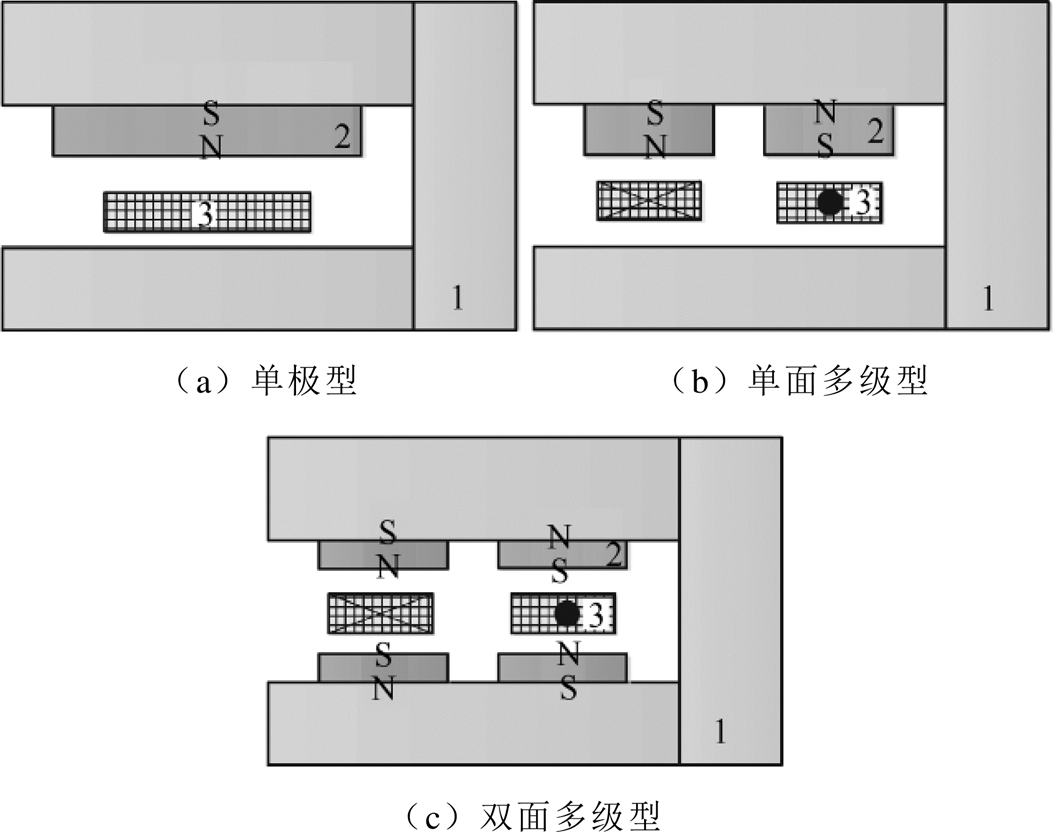
图7 磁路结构
Fig.7 Magnetic circuit structure
文献[40-42]提出在音圈电机中采用轴向充磁结构,如图8所示,推导出轴向充磁圆筒形永磁动圈式直线电机的气隙磁场解析计算公式,将径向充磁与轴向充磁分析比对,证明了在采用相同永磁材料的前提下,轴向充磁能够产生更高的磁通密度,具有明显的聚磁效果。文献[43]在采用轴向充磁的基础上,在音圈电机的中央放置一个磁心以增加径向磁通,电机磁路结构如图9所示。该结构使得内外线圈有效地利用径向磁通来产生轴向力,进一步提高了电机的输出力,使其能够快速驱动大直径的反射镜。
文献[44-46]对非常规的磁极形状和充磁方向的磁极结构对气隙磁通密度的影响进行分析,结果发现,采用非常规方向充磁和非矩形的磁极结构可能对气隙磁通密度有着极大的改善,对于形状不规则的磁极,其制造和加工烧结方式存在一定困难,故文献[46]中,提出一种粘接式的磁极结构。文献[47-48]采用径向轴向混合的磁极阵列,制作了一台应用于快速扫描镜的集中通量式音圈电机,如图10所示。该电机内部中心有一个圆柱形磁体,中心外部有一环形磁体,有助于减小漏磁。
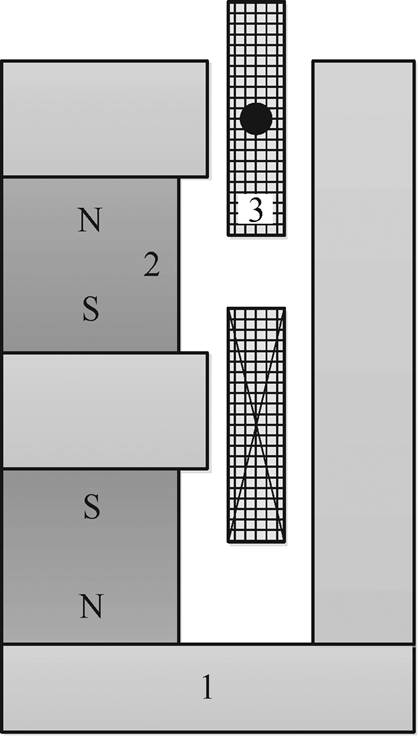
图8 轴向充磁结构
Fig.8 The structure of axial magnetization
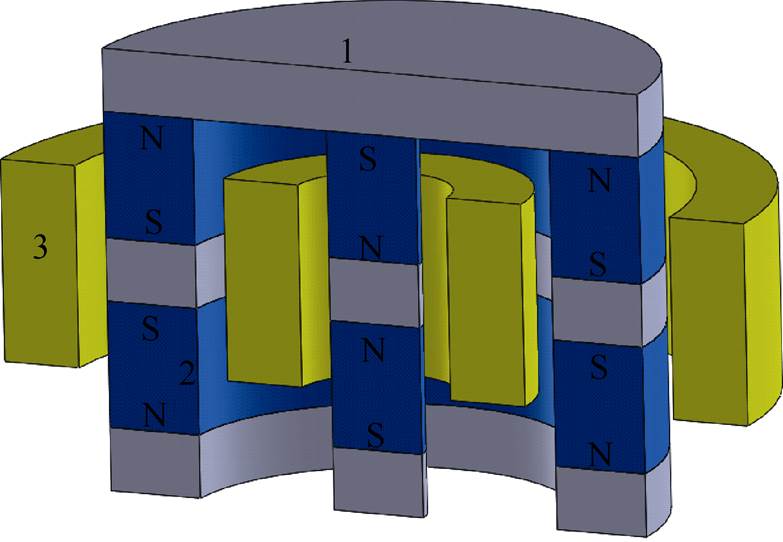
图9 电机磁路结构
Fig.9 The structure of motor magnetic circuit
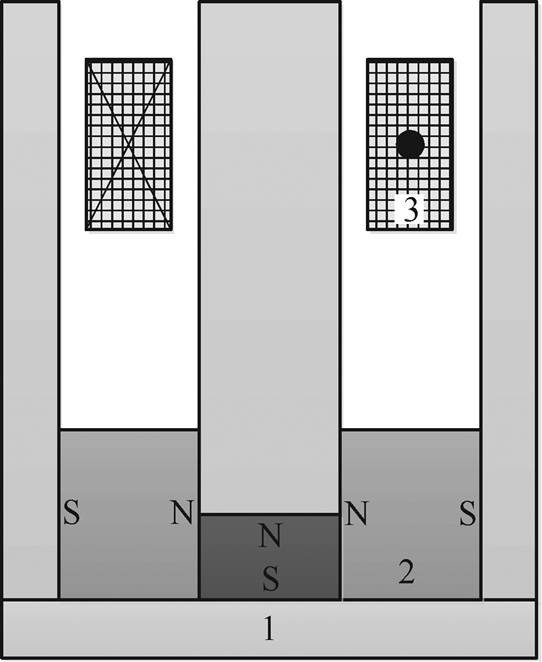
图10 集中通量式音圈电机
Fig.10 Structure of a novel voice coil motor
在文献[49]中,针对圆筒形音圈电机的定子磁极充磁方向的不同对气隙磁通密度的影响进行研究分析,并提出一种将多个非常规充磁方式的环形永磁体组合的定子结构,其中,径向充磁的磁极保证气隙磁通密度的均匀性,上、下两块磁极保证气隙磁通密度的幅值,通过调节3块磁极的高度得到符合要求的气隙磁通密度。文献[50-51]将Halbach阵列应用到音圈电机的设计,并与普通磁极阵列结构进行分析比较,证明只有Halbach阵列能够有效地改变气隙磁通密度,增大幅值、减少波动,还能避免端部轭铁的饱和问题。环形磁钢充磁方向如图11所示。
文献[52-55]中,对单片磁极和单线圈、普通磁极阵列和三线圈、Halbach磁极阵列和三线圈三种结构的音圈电机进行性能比较,采用Halbach磁极阵列和三线圈结构的音圈电机具有最大的推力和最小的力矩波动,磁极结构如图12所示。采用开槽的动圈支架,有助于抑制涡流损耗。从而制作出能够应用于纳米精确定位装置的音圈电机。
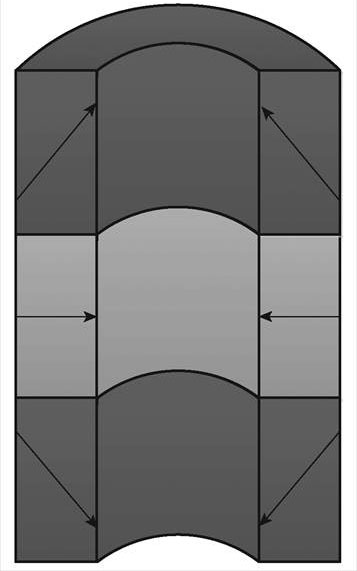
图11 环形磁钢充磁方向
Fig.11 Magnetizing direction of ring permanent magnets

图12 磁极结构
Fig.12 The structure of magnetic pole
音圈电机是无槽电机,音圈厚度不仅影响电机绕组的安培匝数,还影响气隙磁通密度。而电机的输出与这两项的乘积成正比,因此存在一个使电机输出最大化的最佳厚度。通过有限元优化绕组厚度得到最优的绕组结构[56-57]。
导线组成如图13所示。文献[58-60]针对线圈材料对电机性能的影响进行分析,在电机体积不变的前提下,分别采用铜铁混合线和铜包铝(Copper Clad Aluminum, CCA)线作为线圈,铜铁混合线减小磁阻,增大气隙磁通密度,在导线电阻相差不多的前提下,CCA线的质量是铜线质量的40%左右,降低了动子的质量。文献[61]表明,在线圈体积一定的前提下,改变线圈匝数,不会改变推力。

图13 导线组成
Fig.13 Wire composition
提高音圈电机推力的优化主要分为两种:一种为磁路优化,即采用多面多磁极结构、聚磁磁极结构和Halbach磁极结构等磁极阵列,在相同的永磁材料用量下,提高气隙磁通密度,进而实现电机的大推力;另一种为线圈优化,即采用铜铁或铜铝混合线,减小气隙磁阻或动子质量,实现推力的提高,但会增大绕组损耗,故音圈电机高推力的研究主要集中在磁路优化方面。
随着装备制造高精尖发展,在满足推力的基础上对音圈电机的定位精度的要求越来越高,如何提高定位精度是研究的热点之一。
根据音圈电机的基本公式F=BIL,磁通密度B越平稳,力矩波动越小。在电机动子行程范围内,获得相对平稳均匀的气隙磁通密度,能够有效地减小波动。文献[44-46]通过调整磁极的形状和充磁方向,得到符合幅值和均匀性的磁通密度波形。文献[62-63]对音圈电机的永磁体和磁轭进行优化,提出两种永磁体和磁轭的改进方案,其结构如图14所示。通过改进音圈电机结构中的永磁体和磁轭,使其内部垂直峰值磁通密度大大降低。但是,电机输出力会减小,且对永磁体的加工和机械强度有一定要求。高磁通密度与低转矩波动是相反的,要根据实际情况进行选择。
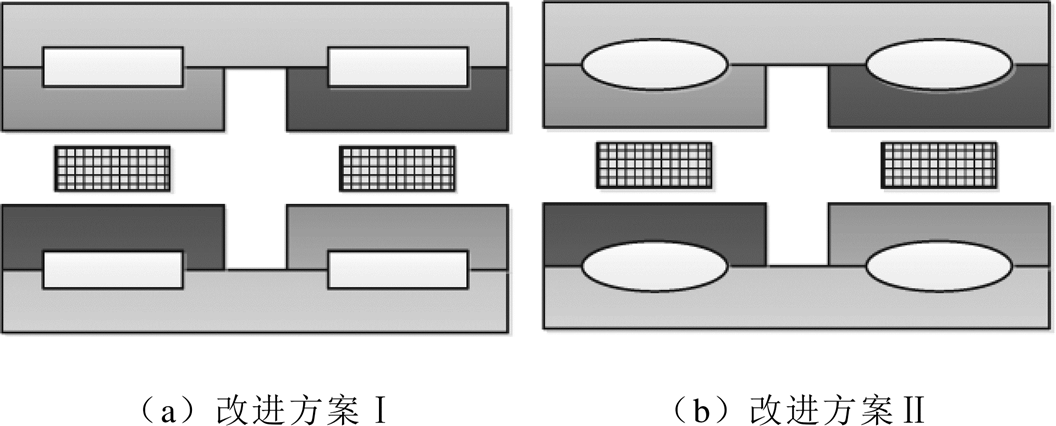
图14 永磁体和磁轭结构
Fig.14 The structure of permanent magnet and yoke
文献[64-65]对漏磁进行分析,磁力线云图如图15所示,永磁体产生的大量磁通通过磁轭中部,磁轭中部的磁通密度很大。磁轭中部高度饱和,此处气隙磁通密度分布不均匀,会造成推力波动的现象。而且,当载流导线运动到磁轭中部时,通电导线在漏磁通的作用下,会产生一个向上的力,将线圈推向磁轭,造成线圈运行的不稳定,因此提出了将永磁体分块或调整永磁体之间的间隙,增大磁极间磁阻达到较少漏磁的目的。
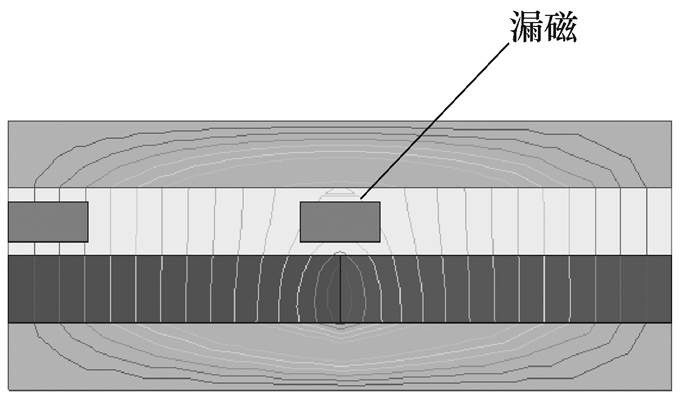
图15 磁力线云图
Fig.15 The cloud map of magnetic field line
端部效应是直线电机的固有特性,但是音圈电机与永磁同步直线电机的端部效应是不同的。端部效应如图16所示,永磁同步电机的端部力是由于电机铁心端部与永磁体磁场相互作用而产生的磁阻力。音圈电机的端部效应是由于载流线圈移动出磁轭端部时会受到一个反向力降低推力[66],因此永磁同步电机端部效应的抑制方法不适用于音圈电机。由涡流阻尼器的思想可知,适当的涡流阻尼可以减弱电机的振动,提高音圈电机的稳定性和控制精 度[67-68],当涡流损耗过大时会对电机的动态性能造成一定影响。关于音圈电机本体设计的大部分文献研究重点都是重塑磁场,提高推力常数。近年来,重庆大学Luo Ciyong等在抑制音圈电机端部效应和涡流损耗方面做了相关研究[69-71],认为减小端部磁阻和引导端部反向磁通对于抑制端部效应有着重要作用。
2017年Luo Ciyong提出在音圈电机底部增加一块长度为a的辅助铁轭形成前相绕组,如图17a所示[69],由于线圈被运动轨道上的磁轭所覆盖,在一定程度上有助于减弱电机的端部效应,增加辅助铁轭导致电机体积增加,通过改变a(铁轭长度),推力特性曲线右移,曲线变宽,则平均推力增加,因此选取最优a值能够得到最优的推力密度。该方法虽然使音圈电机具有较小的端部反向磁通并改善了推力的特性,但端部气隙磁阻仍然占磁路主磁阻相当大一部分,2019年Luo Ciyong提出一种半封闭结构的音圈电机,如图17b所示[70],在前向绕组的基础上,采用Halbach永磁阵列来提高推力密度,并且在音圈电机端部增加一块辅助铁轭,引导端部磁通减小端部磁阻,达到抑制端部效应的目的。
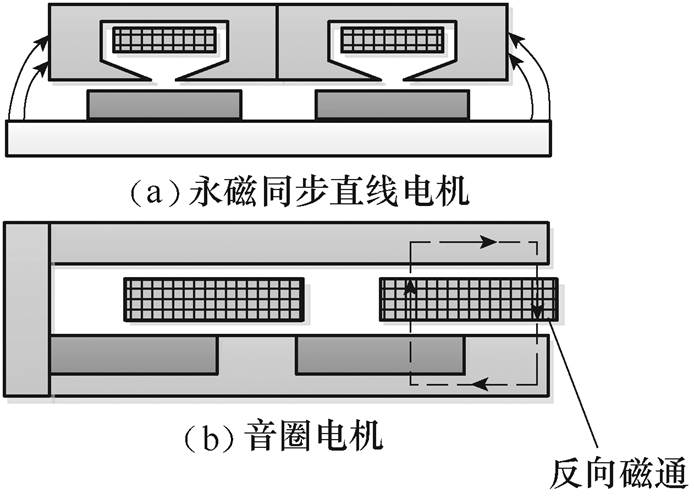
图16 端部效应
Fig.16 The end effect
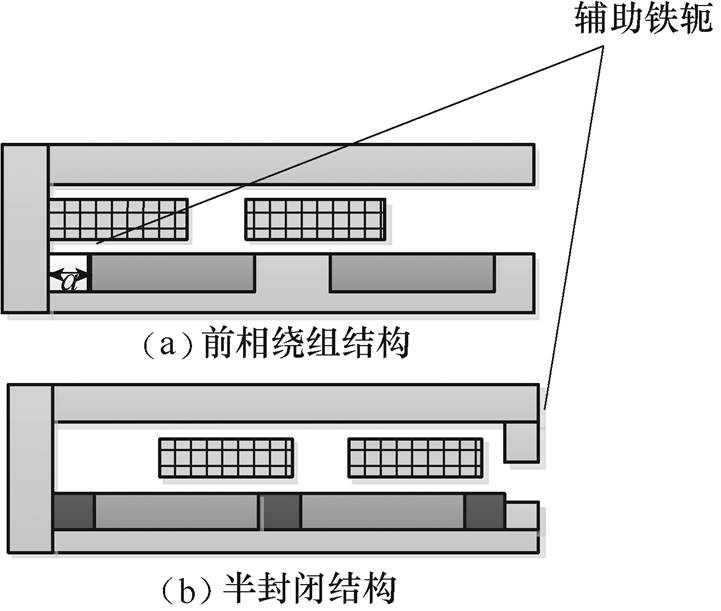
图17 辅助轭铁音圈电机
Fig.17 Auxiliary yoke iron voice coil motor
2020年Luo Ciyong提出一种新的无端铁音圈电机,如图18所示[71],通过取消端铁,增大端部气隙磁阻减少反向磁通来抑制端部效应,且通过有限元分析得出最佳永磁体长度比。
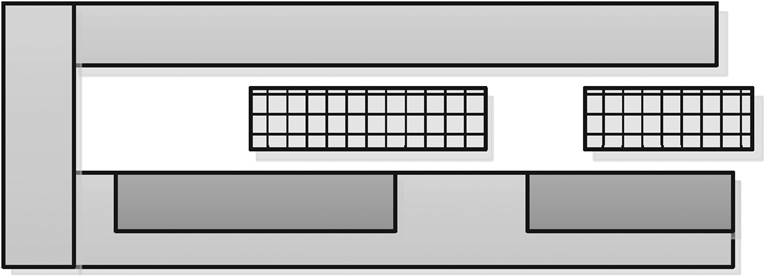
图18 无端铁音圈电机
Fig.18 End-iron-free voice coil motor
根据在传统永磁同步电机中可以通过叠片磁心和套管开孔的方式减少涡流损耗[72-73],提出了三种有利于减弱涡流损耗的铝管结构如图19所示[74],经过分析对比得出,加劲肋并连接开缝的方法对涡流损耗的抑制最显著。
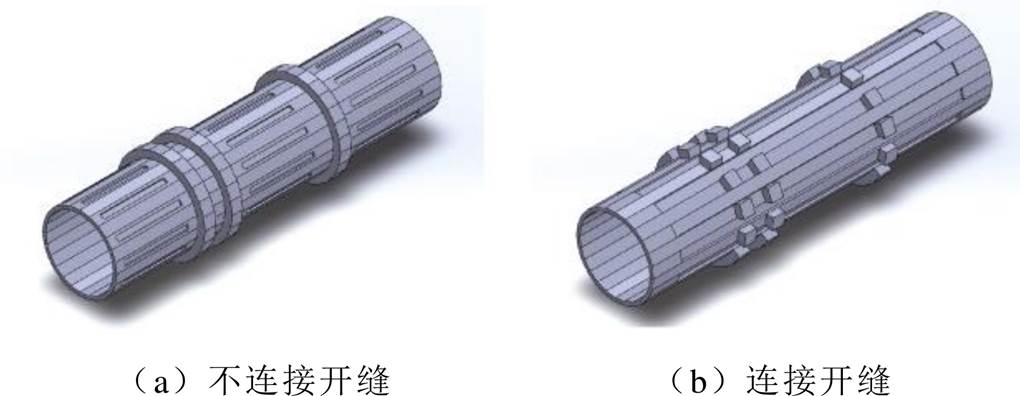
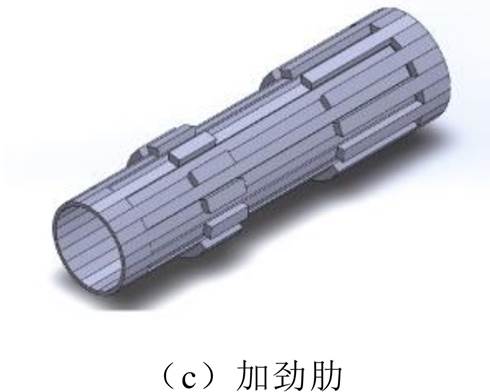
图19 铝管结构
Fig.19 The structure of aluminum tube
通过多个电机实现多自由度运动存在误差叠加的问题,随着精密加工技术的发展,满足多维精密加工系统的高精度、高动态速度的电机成为研究的热点。文献[75-79]提出了三种结构简单、体积小的新型二自由度旋转直线音圈电机作为多维精密运动平台的末端执行器。电机的磁路结构如图20所示,经过实验测试三种电机结构均满足要求。
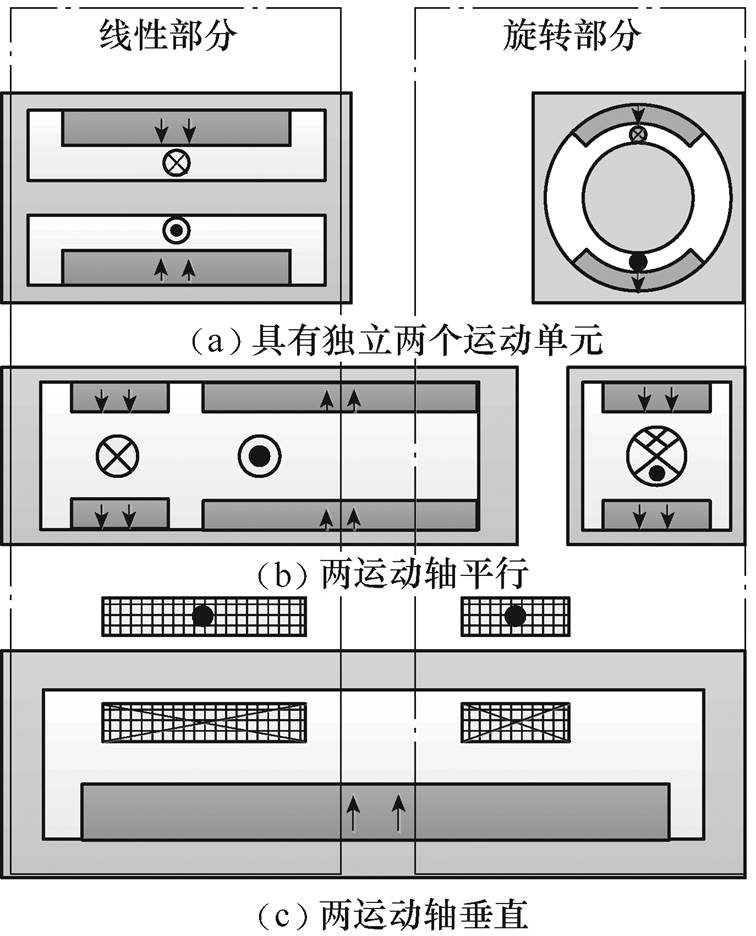
图20 两自由度的音圈电机磁路
Fig.20 The magnetic circuit of two-degree-of-freedom voice coil motor
具有两个运动单元的电机结构具有良好的可控性;运动轴平行的电机结构具有最高的平均直线推力;运动轴垂直的电机结构具有最低的推力脉动和最高的平均旋转力矩。本文还探究了电枢反应对电机性能的影响,实验表明,通过优化电机的电枢反应,能够进一步提高电机的推力密度、降低纹波。
对音圈电机的永磁体、铁轭和端部等结构进行优化,达到均匀动子行程内的磁通密度、抑制音圈电机的端部效应和涡流损耗的目的,都有助于提高电机的定位精度。设计制造多自由度的音圈电机可以减少多个电机以实现多自由度运动时误差叠加,有利于实现加工系统的高精度。
在智能手机摄像模块中,相比于步进电机和压电材料,音圈电机更具优势,多数摄像头采用音圈电机,通过控制音圈电机的电流来实现手机镜头的自动对焦功能。开环音圈电机控制需要簧片提供复位力,存在振铃问题。对此,文献[80]提出摄像头的音圈电机闭环控制,霍尔传感器判断动子位置,镜头控制采用闭环,无需使用簧片。目前,由于手机体积限制以及音圈电机行程,大部分手机仅有自动对焦功能[81],无法实现光学变焦。文献[82]设计如图21所示的音圈电机结构,采取L形绕组,有助于实现大行程。

图21 L形绕组音圈电机结构
Fig.21 The voice coil motor structure of L-shape winding
快速反射镜用来改变光源与目标之间光束指向的装置,需要对光传播方向进行高精度、高动态的控制,实现光束在所需转角范围内的快速精确指向,对系统的环境适应性等也有很高要求[43]。当前快速反射镜平台根据驱动方式的不同分为压电陶瓷驱动和音圈电机驱动两大类。压电陶瓷驱动器的行程相对较小,一般只有几十mm,用于快速反射镜中无法实现较大转角范围。采用音圈电机驱动,可使快速反射镜系统转角范围大、承载能力强,且对振动、冲击等工作环境具有较强的适应性。在国防军工等行程要求较高、反射镜口径较大的系统中,大多采用音圈电机驱动的快速反射镜,如图22所示。
XY精密工作平台如图23所示,是光刻机、引线键合机、PCB钻孔等半导体器件制造和封装仪器的核心部件,工作台对驱动设备的速度和精度要求极高[83],音圈电机具有响应速度快和精度高的优点,在有关半导体制作的领域得到了广泛应用[84]。光刻机和引线键合机是芯片、半导体制作封装的核心设备,我国与西方国家有着较大差距,因此也有着较大的提升空间。目前最好的光刻机是荷兰的AMSL,能够刻出5nm的电路,而国产光刻机要在28nm以上。
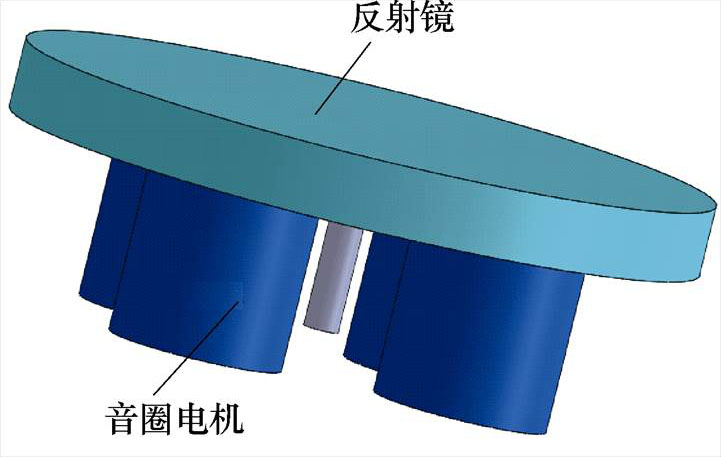
图22 快速反射镜
Fig.22 Fast steering mirror
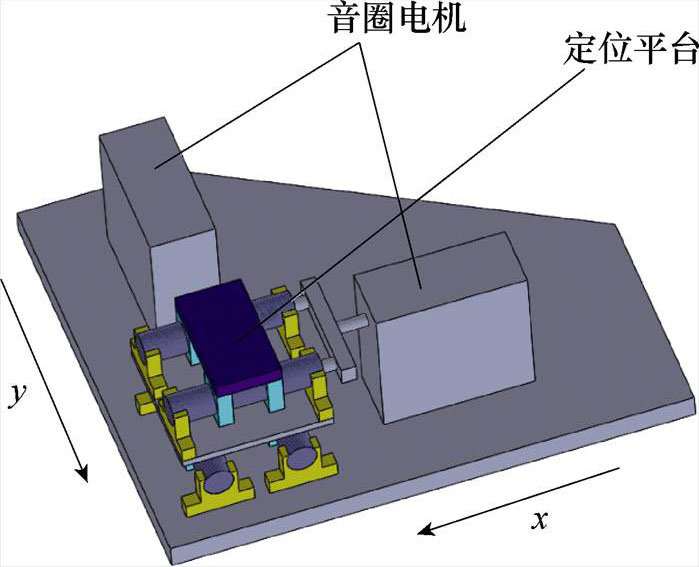
图23 精密工作平台
Fig.23 Precision work bench
随着我国装备制造向着高、精、尖发展,对于音圈电机有着大量的需求,如光刻机、引线键合机等芯片、半导体加工制造装备。随着智能手机逐步引入多摄像头、光学变焦等技术,也会增大音圈电机的需求,因此音圈电机具有广泛的应用前景。目前,音圈电机的研究热点有如下几个方面:
1)提高音圈电机的推力。随着稀土材料加工研制工艺的进步,将高性能的永磁材料以及Halbach阵列和多面多磁极等结构应用到音圈电机的设计中,初步解决音圈电机推力低的问题,但电机的推力依然有着巨大的提升空间,新型拓扑结构的构建和高性能材料的应用,都将有助于进一步提高音圈电机的推力。
2)提高音圈电机的定位精度。音圈电机主要应用于高精度领域,提高电机的定位精度是一个永久课题,如优化拓扑结构以均匀磁通密度、抑制端部效应和涡流损耗,研制多自由度电机解决误差积累问题等。音圈电机在理论上具有无限的控制精度,但在实际使用中会受到外部干扰,进一步深化对音圈电机控制的研究有重要价值。
3)减小音圈电机的体积。在推力不变的前提下,减小电机的体积有利于节省电机的制造材料,同时可间接减小如手机、工作台等设备的体积,节省设备的制造成本,与国家的“去成本”政策相契合。并且,对于精密医疗仪器如扫描仪,航空设备如反射镜平台等设备的体积有着严格限制,音圈电机的小型化研究有重要的实用价值。
因此,音圈电机将朝着高推力、高精度和小型化方向发展。
本文结合国内外对音圈电机本体结构的研究,对音圈电机的技术概况进行综述。本文分别对外磁式和内磁式、短音圈和长音圈、动圈式和动磁式、平板形弧形和圆筒形的结构以相应的特点进行全面阐述,对如何提高音圈电机输出力常数和定位精度的方法进行归纳总结,对音圈电机的应用前景和热点问题进行分析讨论。音圈电机发展至今,以其结构简单、响应速度快、精度高等优越性能得到广泛应用,特别在手机变焦、精密工作台等高精密领域具有突出优势,相信随着研究的不断深入,音圈电机将会得到更进一步的发展。
参考文献
[1] Chen S Y, Lin Heru, Yang Mengchen, et al. Fractional- order fuzzy PID contouring control for a VCMs- based x-y motion stage[C]//International Conference on Control, Automation and Robotics, Singapore, 2020: 236-241.
[2] Chen S Y, Lee C Y. Digital signal processor based intelligent fractional-order sliding-mode control for a linear voice coil actuator[J]. IET Control Theory & Applications, 2017, 11(8): 282-1292.
[3] Cao Yu, Wang Haitao, Lü Tao, et al. Research on large caliber FSM digital control system based on voice coil motor[C]//IEEE Advanced Information Technology, Electronic and Automation Control Conference, Chengdu, China, 2019: 2778-2781.
[4] Wang Baochao, Liu Cheng, Wu Zhiwei, et al. LCL filter design and implementation for improving transient position tracking control performance of voice coil motor[J]. IEEE Access, 2020, 8: 4963- 4971.
[5] 凌志健, 赵文祥, 吉敬华. 高推力永磁直线作动器及其关键技术综述[J]. 电工技术学报, 2020, 35(5): 1022-1035.
Ling Zhijian, Zhao Wenxiang, Ji Jinghua. Overview of high force density permanent magnet linear actuator and its key technology[J]. Transactions of China Electrotechnical Society, 2020, 35(5): 1022- 1035.
[6] 张春雷, 张辉, 叶佩青, 等. 两相圆筒型永磁同步直线电机无传感算法[J]. 电工技术学报, 2019, 34(23): 4901-4908.
Zhang Chunlei, Zhang Hui, Ye Peiqing, et al. Research on sensorless algorithm of two phase tubular permanent magnet synchronous linear motor[J]. Transactions of China Electrotechnical Society, 2019, 34(23): 4901-4908.
[7] Huang Weikang, Cao Li, Huang Wenxin, et al. Research on voice coil motor for a new construction with wireless power supply[C]//International Con- ference on Electrical Machines and Systems, Harbin, China, 2019: 1-6.
[8] 陈晓, 赵文祥, 吉敬华, 等. 考虑边端效应的双边直线永磁游标电机模型预测电流控制[J]. 电工技术学报, 2019, 34(1): 49-57.
Chen Xiao, Zhao Wenxiang, Ji Jinghua, et al. Model predictive current control of double-side linear vernier permanent magnet machines considering end effect[J]. Transactions of China Electrotechnical Society, 2019, 34(1): 49-57.
[9] 秦伟, 范瑜, 徐洪泽, 等. 高温超导运动磁场电磁Halbach初级结构直线感应磁悬浮电机[J]. 电工技术学报, 2018, 33(23): 5427-5434.
Qin Wei, Fan Yu, Xu Hongze, et al. A linear induction maglev motor with HTS traveling magnetic electromagnetic Halbach array[J]. Transactions of China Electrotechnical Society, 2018, 33(23): 5427- 5434.
[10] 许孝卓, 孙震, 汪旭东, 等. Halbach交替极永磁同步直线电机特性分析[J]. 电工技术学报, 2019, 34(9): 1825-1833.
Xu Xiaozhuo, Sun Zhen, Wang Xudong, et al. Characteristic of a novel permanent magnet linear synchronous motor with Halbach array consequent- pole[J]. Transactions of China Electrotechnical Society, 2019, 34(9): 1825-1833.
[11] Ma Guangtong, Gong Tianyong, Zhang Han, et al. Experiment and simulation of REBCO conductor coils for an HTS linear synchronous motor[J]. IEEE Transactions on Applied Superconductivity, 2017, 27(4): 1-5.
[12] 杨光. 基于三维磁场计算的永磁音圈电机结构优化设计[D]. 天津: 天津大学, 2004.
[13] 常雪峰, 陈幼平, 艾武, 等. 音圈直线电动机设计、控制及应用综述[J]. 微电机, 2008, 41(11): 66-69.
Chang Xuefeng, Chen Youping, Ai Wu, et al. Design and control application of voice coil linear motors[J]. Micromotors, 2008, 41(11): 66-69.
[14] 张阳, 周惠兴, 曹荣敏, 等. 基于有限元分析的弧形音圈电机综合优化设计[J]. 微电机, 2010, 43(11): 28-33.
Zhang Yang, Zhou Huixing, Cao Rongmin, et al. Comprehensive optimization design of a rotary VCM based on FEM[J]. Micromotors, 2010, 43(11): 28-33.
[15] 兴连国, 周惠兴, 侯书林, 等. 音圈电机研究及应用综述[J]. 微电机, 2011, 44(8): 82-87.
Xing Lianguo, Zhou Huixing, Hou Shulin, et al. Research and application of voice coil motor[J]. MicroMotors, 2011, 44(8): 82-87.
[16] 张大卫, 冯晓梅. 音圈电机的技术原理[J]. 中北大学学报: 自然科学版, 2006, 27(3): 224-228.
Zhang David, Feng Xiaomei. Technical principles of voice coil motor[J]. Journal of North University of China: Natural Science Edition, 2006, 27(3): 224- 228.
[17] 王晓远, 杨光, 闫杰. 两种结构的光盘驱动器音圈电机性能分析[J]. 微电机, 2005, 38(2): 7-9.
Wang Xiaoyuan, Yang Guang, Yan Jie. Performance analysis of two voice coils motors wiyt different kinds of structure for disk driver[J]. Micromotors, 2005, 38(2): 7-9.
[18] 王道生. 高速高精度磁头定位机构的设计[J]. 电子计算机参考资料, 1978(7): 58-76.
Wang Daosheng. Design of high speed and high precision magnetic head positioning mechanism[J]. Computer Engineering and Applications, 1978(7): 58-76.
[19] 何松波, 顾鸿祥. 自屏蔽式音圈电机[J]. 计算机研究与发展, 1984(4): 27-34.
He Songbo, Gu Hongxiang. Self-shielded voice coil motor[J]. Journal of Computer Research and Deve- lopment, 1984(4): 27-34.
[20] Gong Zhean, Zhang Zhishen, Zhang Longlong, et al. Reliability enhancement test of vertical voice-coil motor on wafer stage of lithography machine[C]// International Conference on Quality, Chengdu, China, 2013: 991-995.
[21] 罗敢, 王岳环, 张彪. 光刻机光头调焦音圈电机的结构设计[J]. 微电机, 1998, 31(6): 7-11.
Luo Gan, Wang Yuehuan, Zhang Biao. VCM structure design for optical-head focusing in optical pre- etching machine[J]. Micromotors, 1998, 31(6): 7-11.
[22] 张宝铭, 王春茹. 高精度音圈电动机[J]. 微电机, 1995, 28(1): 50-51.
Zhang Baoming, Wang Chunru. High-precision voice coil motor[J]. Micromotors, 1995, 28(1): 50-51.
[23] 冯胜东. 大量程触针式仪器测力控制系统研究[D]. 武汉: 华中科技大学, 2015.
[24] Rashidi A S, 杨媛霞. 用希土磁钢改善音圈电机性能[J]. 电子计算机动态, 1979(2): 40-42.
Rashidi A S, Yang Yuanxia. Improving the per- formance of voice coil motors with rare earth magnets[J]. Journal of Computer Research and Development, 1979(2): 40-42.
[25] 郑大材, 吕辉. 短音圈电机设计要求及使用[J]. 西北电讯工程学院学报, 1979, 6(3): 113-123.
Zheng Dacai, Lü Hui. Design requirements and use of short voice coil motors[J]. Journal of Xidian University, 1979, 6(3): 113-123.
[26] Lee D J, Woo K S, Park N C, et al. Design and optimization of a linear actuator for subminiature optical storage devices[J]. IEEE Transactions on Magnetics, 2005, 41(2): 1055-1057.
[27] Chou P C, Lin Yucheng, Cheng S. A novel seesaw swivel actuator design and fabrication[J]. IEEE Transactions on Magnetics, 2010, 46(7): 2603-2610.
[28] Djamari D W, Ong C J, Yap F F. An investigation into the use of four-bar linkage mechanism as actuator for hard-disk drive[J]. IEEE Transactions on Magnetics, 2013, 49(6): 2466-2472.
[29] 周惠兴, 黄灿, 王磊, 等. 大功率动磁式音圈电机优化及试验研究[J]. 北京信息科技大学学报, 2014, 29(3): 1-4.
Zhou Huixing, Huang Can, Wang Lei, et al. Opti- mization and experimental research for a high-power moving magnet voice coil motor[J]. Journal of Beijing Information Science & Technology University, 2014, 29(3): 1-4.
[30] 凌金福. 动圈式直线电机的研制和应用[J]. 电工电能新技术, 1983, 2(3): 44-49.
Ling Jinfu. Development and application of moving coil linear motor[J]. Advanced Technology of Electrical Engineering and Energy, 1983, 2(3): 44-49.
[31] 王晓伟. 高推力密度圆筒型音圈电机的结构设计研究[D]. 重庆: 重庆大学, 2018.
[32] 夏瑞阳. 圆柱形音圈电机结构的设计及优化[D]. 洛阳: 河南科技大学, 2012.
[33] 陈国真, 徐斯强, 刘品宽, 等. 大行程快速反射镜的结构设计及带宽特性[J]. 光学精密工程, 2020, 28(1): 90-101.
Chen Guozhen, Xu Siqiang, Liu Pinkuan, et al. Structural design and bandwidth characteristic of a fast steering mirror with large travel range[J]. Optics and Precision Engineering, 2020, 28(1): 90-101.
[34] Lou Yunjiang, Yang Xiansheng, Li Ke, et al. Design and optimization of a linear voice coil motor for LED die bonders[C]//IEEE International Conference on Information and Automation, Yinchuan, China, 2013: 1011-1016.
[35] Peng Bo, Quan JianZhou, Yin Zhouping, et al. The analysis and control of pick-and-place process in flip-chip[C]//International Conference on Mechanical and Electronics Engineering, Kyoto, Japan, 2010: 404-408.
[36] Kim D H, Lee D Y, Jung C G, et al. Improvement of operating characteristics for MC-LOA taking account of permanent magnet arrangement[J]. IEEE Transa- ctions on Magnetics, 2004, 40(4): 2038-2040.
[37] 凌金福, 李世毅, 杨媛霞. 双磁体音圈电机气隙磁场的分析[J]. 电工技术杂志, 1984, 5(6): 25-29.
Ling Jinfu, Li Shiyi, Yang Yuanxia. Analysis of air gap magnetic field of dual magnet voice coil motor[J]. Electrotechnical Application, 1984, 5(6): 25-29.
[38] Guo Hong, Wang Dayu, Xu Jinquan. Research on a high-frequency response direct drive valve system based on voice coil motor[J]. IEEE Transactions on Power Electronics, 2013, 28(5): 2483-2492.
[39] Wu Shuai, Jiao Zongxia, Yan Liang, et al. Deve- lopment of a direct-drive servo valve with high- frequency voice coil motor and advanced digital controller[J]. IEEE/ASME Transactions on Mechatro- nics, 2014, 19(3): 932-942.
[40] 凌志鹏, 李晋川, 黄学进, 等. 改进型音圈式直线电动机有限元优化设计[J]. 微电机, 2007, 40(10): 18-20.
Ling Zhipeng, Li Jinchuan, Huang Xuejin, et al. Finite element optimal design of improved linear motor of voice coil type[J]. Micromotors, 2007, 40(10): 18-20.
[41] 王淑红, 熊光煜. 新型筒型永磁动圈式直线电动机气隙磁场解析分析[J]. 电工技术学报, 2007, 20(5): 40-44.
Wang Shuhong, Xiong Guangyu. Analysis of air-gap field in a new tubular linear PM motor with moving coil[J]. Transactions of China Electrotechnical Society, 2007, 20(5): 40-44.
[42] Lu Haiwei, Zhu Jianguo, Lin Zhiwei, et al. A miniature short stroke linear actuator-design and analysis[J]. IEEE Transactions on Magnetics, 2008, 44(4): 497-504.
[43] Shinshi T, Shimizu D, Kodeki K, et al. A fast steering mirror driven by voice coil motors and supported by magnetic suspension[C]//International Conference on Mechatronics Technology, Salerno, Italy, 2019: 1-4.
[44] Meessen K J, Gysen B L J, Paulides J J H, et al. Halbach permanent magnet shape selection for slotless tubular actuators[J]. IEEE Transactions on Magnetics, 2008, 44(11): 4305-4308.
[45] Remy M, Lemarquand G, Castagnede B, et al. Ironless and leakage free voice-coil motor made of bonded magnets[J]. IEEE Transactions on Magnetics, 2008, 44(11): 4289-4292.
[46] Li Liyi, Huang Xuzhen, Pan Donghua, et al. Magnetic field of a tubular linear motor with special permanent magnet[J]. IEEE Transactions on Plasma Science, 2011, 39(1): 83-86.
[47] 石本义, 陈四海, 吴鑫, 等. 基于遗传算法的音圈电机的优化设计[C]//先进光学技术及其应用研讨会论文集, 杭州, 中国, 2009: 137-141.
[48] Yu Bin, Fu Hongwei, Wang Li. Electromagnetic field analysis and calculation of voice coil motor with a concentrated magnetic structure[C]//International Conference on Electrical Machines and Systems, Harbin, China, 2019: 1-4.
[49] Lemarquand V, Ravaud R, Lemarquand G. A new linear voice-coil motor for ironless loudspeakers: analytical study[C]//International Conference on Electrical Machines, Rome, Italy, 2010: 1-5.
[50] Xu Zhaoping, Chang Siqin. Improved moving coil electric machine for internal combustion linear generator[J]. IEEE Transactions on Energy Con- version, 2010, 25(2): 281-286.
[51] Li Liyi, Pan Donghua, Tang Yongbin, et al. Analysis of flat voice coil motor for precision positioning system[C]//International Conference on Electrical Machines and Systems, Beijing, China, 2011: 1-4.
[52] Wu Shuai, Jiao Zongxia, Yan Liang, et al. Deve- lopment of a direct-drive servo valve with high- frequency voice coil motor and advanced digital controller[J]. IEEE/ASME Transactions on Mechatronics, 2014, 19(3): 932-942.
[53] Dong Liang, Chen Jinhua, Zhang Chi, et al. A novel voice coil motor used in nano-positioning device[C]// International Conference on Electrical Machines and Systems, Pattaya, Thailand, 2015: 1997-2002.
[54] Dong Liang, Chen Jinhua, Zhang Chi, et al. Design and comparison of three-type VCMs for nano- positioning system[C]//IEEE 11th Conference on Industrial Electronics and Applications, Hefei, China, 2016: 656-1660.
[55] Yan Liang, Zhang Lei, Jiao Zongxia, et al. Armature reaction field and inductance of coreless moving-coil tubular linear machine[J]. IEEE Transactions on Industrial Electronics, 2014, 61(12): 6956-6965.
[56] Yu Bin, Fu Hongwei, Wang Li. Electromagnetic field analysis and calculation of voice coil motor with a concentrated magnetic structure[C]//International Conference on Electrical Machines and Systems, Harbin, China, 2019: 1-4.
[57] Luo Ciyong, Sun Jun, Liao Yong, et al. Analysis and design of ironless toroidal winding of tubular linear voice coil motor for minimum copper loss[J]. IEEE Transactions on Plasma Science, 2019, 47(5): 2369- 2375.
[58] Sanada M, Morimoto S. Experimental verification of thrust improvement in voice coil linear actuator using combined wire of copper and iron[C]//IEEE Industry Applications Annual Meeting, New Orlearns, USA, 2007: 490-494.
[59] Cakal G, Zeinali R, Keysan O. Design and optimi- zation of reduced torque ripple rotary voice coil motor[C]//International Conference on Electrical Machines, Alexandroupoli, Greece, 2018: 663-669.
[60] Guo Hong, Wang Dayu, Xu Jinquan. Research on a high-frequency response direct drive valve system based on voice coil motor[J]. IEEE Transactions on Power Electronics, 2013, 28(5): 2483-2492.
[61] 林兼. 音圈电机的型式和性能[J]. 电子计算机动态, 1978(7): 62-68.
Lin Jian. Type and performance of voice coil motor[J]. Journal of Computer Research and Deve- lopment, 1978(7): 62-68.
[62] Chi Feng, Wu Liwei, Yang Xiaofeng. Optimum design of voice coil motor using for nano-stage in lithographic equipment[C]//Proceeding of the 11th World Congress on Intelligent Control and Auto- mation, Shenyang, China, 2014: 2540-2543.
[63] Kim C, Kim Y. Design and analysis of linear voice coil motor for automatic transmission[C]//International Conference on Electrical Machines and Systems, Chiba, Japan, 2016: 1-5.
[64] Liu Yu, Zhang Ming, Zhu Yu, et al. Optimization of voice coil motor to enhance dynamic response based on an improved magnetic equivalent circuit model[J]. IEEE Transactions on Magnetics, 2011, 47(9): 2247- 2251.
[65] Smith K J, Graham D J, Neasham J A. Design and optimization of a voice coil motor with a rotary actuator for an ultrasound scanner[J]. IEEE Transa- ctions on Industrial Electronics, 2015, 62(11): 7073- 7078.
[66] 张弛, 汤廷孝, 邓益民. 设计辅助齿抑制永磁同步直线电机端部效应[J]. 机械制造, 2018, 56(11): 45-49.
Zhang Chi, Tang Tingxiao, Deng Yimin. Design auxiliary teeth to suppress the end effect of permanent magnet synchronous linear motor[J]. Machinery, 2018, 56(11): 45-49.
[67] Lee S G, Kim S A, Saha S, et al. Optimal structure design for minimizing detent force of PMLSM for a ropeless elevator[J]. IEEE Transactions on Magnetics, 2014, 50(1): 1-4.
[68] Kim Y, Sohn B, Youm W, et al. Voice coil motor nano stage with an eddy current damper[C]// International Conference on Control, Automation, Robotics and Vision, Hanoi, Vietnam, 2008: 1714- 1717.
[69] Luo Ciyong, Sun Jun, Wang Xiaowei, et al. Design of voice coil motor with the forward winding for linear vibro-impact systems[J]. IEEE Transactions on Magnetics, 2017, 53(8): 1-9.
[70] Luo Ciyong, Lin Zhonglan, Sun Jun. Design of linear voice coil motor with semi-closed structure[J]. IET Electric Power Applications, 2019, 13(10): 1574- 1579.
[71] Luo Ciyong, Li Xingwang, Liao Yong, et al. Design of end-iron-free voice coil motor with appropriate PM length ratio[J]. IEEE Transactions on Energy Conversion, 2020, 35(2): 1139-1146.
[72] Jun H W, Seol H S, Lee J. Effect of pole-slot combination on eddy-current formation in PMSM rotor assembly including retaining plate structure[J]. IEEE Transactions on Magnetics, 2017, 53(11): 1-5.
[73] Jun H W, Lee J, Lee H W, et al. Study on the optimal rotor retaining sleeve structure for the reduction of eddy-current loss in high-speed SPMSM[J]. IEEE Transactions on Magnetics, 2015, 51(3): 1-4.
[74] Luo Ciyong, Zhao Rui. Analysis and restraining of eddy current damping effect in linear voice coil motor[J]. IET Electric Power Applications, 2019, 14(5): 837-842.
[75] Zhang Zijiao, Zhou Haibo, Duan Jian, et al. Design and analysis of two-degree-of-freedom voice coil motors for linear-rotary motion[C]//International Conference on Electrical Machines and Systems, Chiba, Japan, 2016: 1-6.
[76] Luo Meizhu, Zhou Haibo, Duan Jian, et al. Design and analysis of a servo control system for a novel linear-rotary voice coil motor[C]//International Con- ference on Electrical Machines and Systems, Chiba, Japan, 2016: 13-16.
[77] Zhang Zijiao, Zhou Haibo, Duan Jian. Design and analysis of a high acceleration rotary-linear voice coil motor[J]. IEEE Transactions on Magnetics, 2017, 53(7): 1-9.
[78] Zhang Zijiao, Luo Meizhu, Zhou Haibo, et al. Design and analysis of a novel two-degree-of-freedom voice coil motor[J]. IEEE/ASME Transactions on Mechatronics, 2019, 24(6): 2908-2918.
[79] Luo Meizhu, Zhang Zijiao, Luo Chaoqun. Analysis and optimization on armature reaction of a rotary- linear voice coil motor[C]//International Conference on Electrical Machines and Systems, Harbin, China, 2019: 1-4.
[80] Liu C S, Ko S S, Lin P D. Experimental characteri- zation of high-performance miniature auto-focusing VCM actuator[J]. IEEE Transactions on Magnetics, 2011, 47(4): 738-745.
[81] Lai L K, Tsai C L, Liu T S. Design of compact linear electromagnetic actuator for auto-focusing in phone camera[J]. IEEE Transactions on Magnetics, 2011, 47(12): 4740-4744.
[82] Hsieh C L, Liu C S. Design of a voice coil motor actuator with l-shape coils for optical zooming smartphone cameras[J]. IEEE Access, 2020, 8: 20884-20891.
[83] Jeong J, Jo J, Park K. Characteristic analysis and improvement of VCM/PZT driven xy nanostage for atomic force microscope[C]//International Conference on Control, Automation and Systems, Gwangju, South Korea, 2013: 1381-1383.
[84] Bang Y B, Lee C H, Cho S Y, et al. Design of a high-speed, short-stroke xy-stage with counter- balance mechanisms[C]//International Conference on Control, Automation and Systems, Busan, South Korea, 2015: 123-125.
Overview of Structure Optimization and Application of Voice Coil Motor
Abstract Voice coil motor is a linear motor that can convert electrical energy into linear motion mechanical energy without any mechanical transmission. Due to the advantages of simple structure, small size, fast response speed, high positioning accuracy and easy control, voice coil motors are widely used in many electrical fields. This paper briefly described the theoretical basis of the voice coil motor, and explained the working principle, structural classification and characteristics of each structure of voice coil motor. Besides, based on the research of domestic and foreign scholars on the structure optimization of voice coil motor, this paper summarized the methods of improving the force constant and positioning accuracy of voice coil motor. Furthermore, the main application fields of voice coil motor were summarized, and their development trends and research hotspots were discussed and prospected.
keywords:Voice coil motor, structure optimization, force constant, positioning accuracy
中图分类号:TM359.9
DOI: 10.19595/j.cnki.1000-6753.tces.200725
国家科技重大专项资助项目(2012ZX04001051)。
收稿日期 2020-06-30
改稿日期 2020-12-02
柴嘉伟 男,1994年生,硕士,研究方向为永磁电机多目标优化。E-mail: 2482572585@qq.com(通信作者)
贵献国 男,1972年生,博士,副教授,研究方向为特种电机多物理场耦合优化设计、永磁电机驱动与控制。E-mail: xianggui@hit.edu.cn
(编辑 陈 诚)